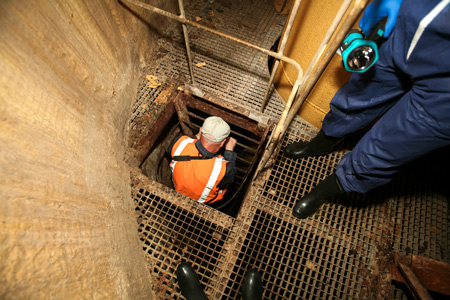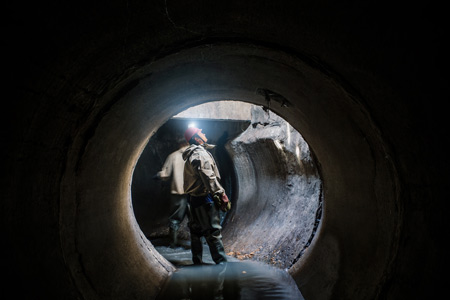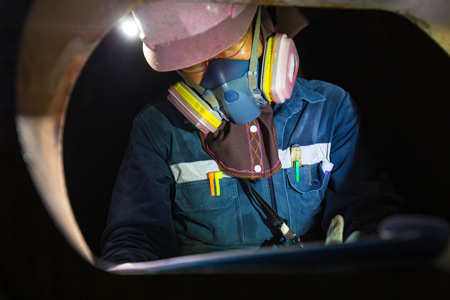Confined Spaces Training Courses
Courses on working in tanks, pipes and drainage
These training courses are designed to provide individuals with the necessary knowledge and skills needed to safely enter, work and manage confined spaces.
This includes risk assessment, hazard identification, planning and implementing emergency procedures and the proper use of personal protective equipment (PPE).
These training courses are accredited by City & Guilds.
Confined spaces training courses are available at the following EAP Training centres:
- Leeds
- Derby
- Middlewich
- West Bromwich
- Bridgewater
- Staples Corner

Level 2 Award – Working in Low Risk Confined Spaces
£225 per candidate
This training course focuses on providing the candidates with the foundational skills and knowledge required to safely and effectively work in low-risk confined spaces. It reflects the national standard and covers both water and non-water industry areas.
This course culminates in a practical assessment and short theory test.
Course content is as follows:
Theory
- Confined Spaces Regulations 1997& Approved Code of Practice
- Identification of a confined space
- Confined space classifications:
- Water industry national classifications
- National occupational standard
- Risk assessment & workplace safety
- Operation of a safe system of work
- Following and preparing a method statement
- Use of permit to work control measures
- Emergency planning
- Personal Protective Equipment
- Gas detection and ventilation
- Hygiene and first aid
Assessment
- Practical observation - side entry and top entry no deeper than 3 metres
- Undertaking risk assessments throughout the exercise to identify hazards
- Responding to risks and hazards
- Dealing promptly with emergencies
- Short answer question paper

Level 2 Award - Working in Medium Risk Confined Spaces
£375-£545 per candidate
This training course is designed to provide candidates with the skills and knowledge to work in confined spaces where there is a realistic expectation of specified risks. This includes an understanding of legislation, safe systems of work, conducting risk assessment and dealing with emergencies. It reflects the national standard and covers both water and non-water industry areas.
This course culminates in a practical assessment and short theory test.
Course content is as follows:
Theory
- Confined Spaces Regulations 1997& Approved Code of Practice
- Identification of a confined space
- Confined space classifications:
- Water industry national classifications
- National occupational standard
- Risk assessment & workplace safety
- Operation of a safe system of work
- Following and preparing a method statement
- Use of permit to work control measures
- Emergency planning
- Personal Protective Equipment
- Gas detection and ventilation
- Hygiene and first aid
Assessment
- Practical observation - side entry and top entry no deeper than 3 metres
- Undertaking risk assessments throughout the exercise to identify hazards
- Responding to risks and hazards
- Dealing promptly with emergencies
- Short answer question paper

Level 2 Award - Working in High Risk Confined Spaces
£495 per candidate
This course provides candidates with the knowledge and skills necessary to work in confined spaces where there are hazards that cannot be controlled or eliminated, such as unknown atmospheric or access issues. It reflects the national standard and covers both water and non-water industry areas. This includes identifying hazards, the use of specialist PPE and communication protocols specific to high-risk environments.
This course culminates in a practical assessment and short theory test.
Course content is as follows:
Theory
- Confined Spaces Regulations 1997& Approved Code of Practice
- Identification of a confined space
- Confined space classifications:
- Water industry national classifications
- National occupational standard
- Risk assessment & workplace safety
- Operation of a safe system of work
- Following and preparing a method statement
- Use of permit to work control measures
- Emergency planning
- Personal Protective Equipment
- Gas detection and ventilation
- Hygiene and first aid
Assessment
- Practical observation - side entry and top entry no deeper than 3 metres
- Undertaking risk assessments throughout the exercise to identify hazards
- Responding to risks and hazards
- Dealing promptly with emergencies
- Short answer question paper
TrainingEAP are dedicated to promoting safe working environments across the UK.
If you have any further questions about our construction health and safety training, facilities or accrediting bodies, please let us know at
